How To Influence Others by Drawing, Even if You Flunked Art
[This is a guest article by Dan Roam, excerpted from his new book about how to lead and persuade by drawing, Draw to Win. Want more from Dan in his own words? Tune into my conversation with him on The Brainfluence Podcast.]
This chapter will not show you how to draw like a talented artist; this chapter will show you how to draw like a clear thinker.
If you think you can’t draw, you’ll see that you’re mistaken. You can draw; you just need to learn two simple tools, see them in action, and then practice using them a couple of times. That’s all it takes. Make the analogy to talking. The first time you tried to talk, you didn’t do very well. But with tools, training, and practice, you got good at it. It’s the same here; just as you don’t need to be a novelist to talk, you don’t need to be an artist to be visual.
Drawing is like talking, except you use shapes instead of words, says @Dan_Roam Click To Tweet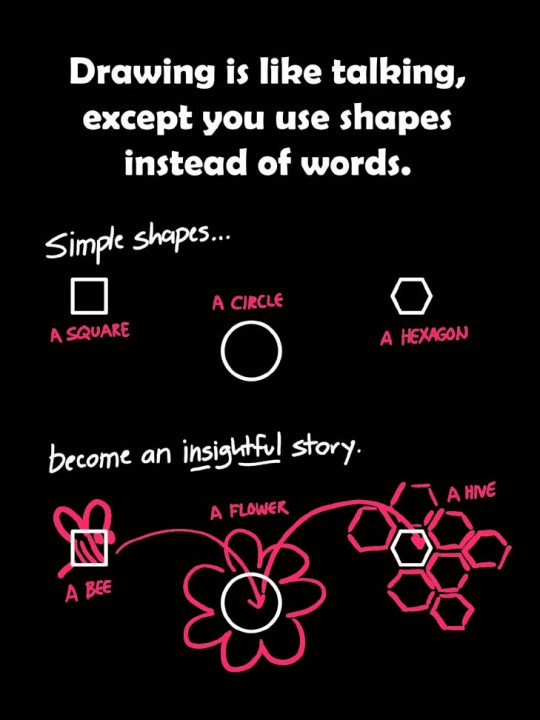
Drawing the First Line Is the Hardest— So Don’t Even Think About It
The one time in drawing when you don’t think is when you draw the first line. Because the first line is the hardest, you really should tell your mind to quiet down—and then put your pen on your paper and draw a circle.
- Draw a circle. Your drawing is started.
Then, kick your brain back into gear by thinking up a name for that circle. You can call it almost anything, whatever is at the top of your mind as you approach the idea you want to convey: me, you, today, tomorrow, profit, our product, my company, the globe. As long as you call it something, your thought process has started. Give your circle a name.
- Write it in the circle. Now your thinking has started too.
Now your thinking has started too.
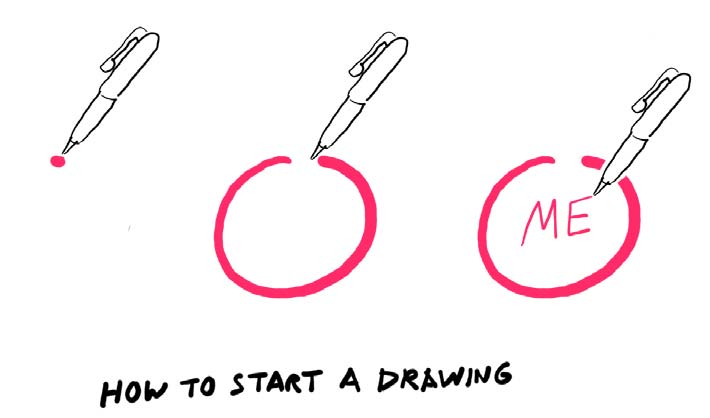
Once You’ve Drawn the First Circle, the Next Is Easy
Add a few more shapes beside your first circle—a square, a triangle, and a star. Now connect them with arrows. Now label them; like magic, you’ve created a schematic diagram of an idea.
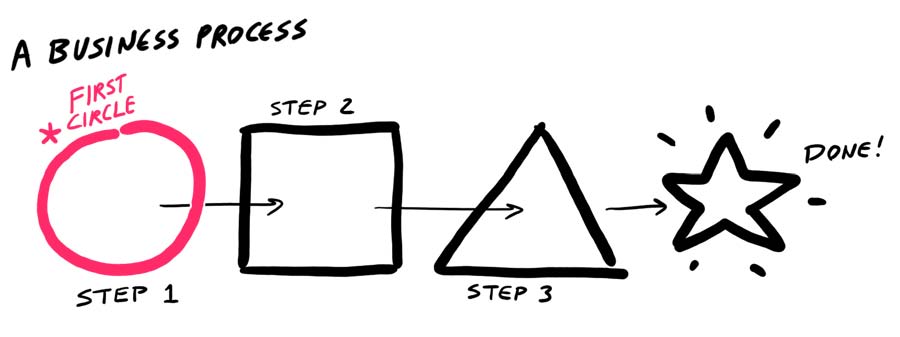
Most of the time, the simple act of drawing the first circle and naming it is all you need to get started. Then just continue the process. Almost always, one drawing leads to another, which leads to another.
Keep Adding (and Naming) Circles, and You Can Draw All Kinds of Ideas
Look for the first circles in the drawings below. Do you see how many different ideas you can express just by adding more circles, more labels, and a few details?
First-circle drawing 1. Three intersecting circles become a Venn diagram that illustrates the overlap of three components of an idea; in this case how to make a perfect cup of coffee. (The same drawing might illustrate your business offerings, your customer segments, or your marketing plan.)
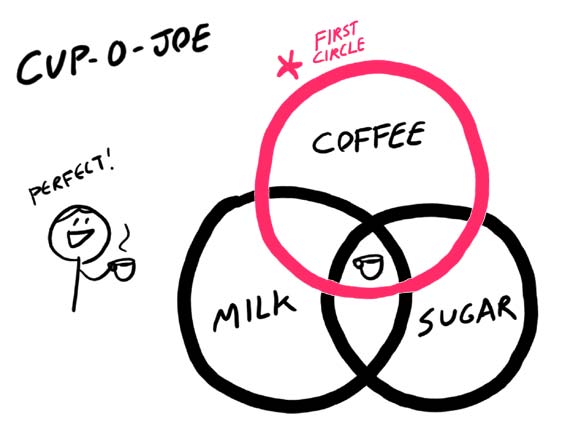
First-circle drawing 2. Three circles with simple faces become an insightful map of a competitive landscape; in this case the eternal triangle of human heartbreak. (The same drawing might illustrate your competitive positioning, your customer acquisition approach, or your hiring needs.)
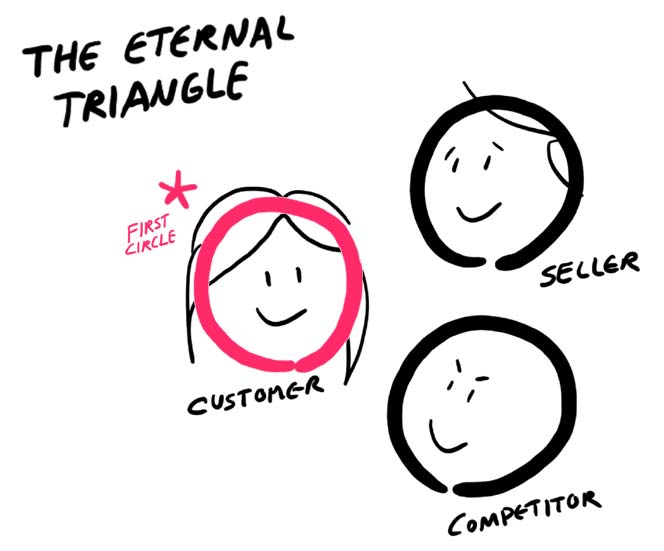
First-circle drawing 3. Two big circles, two small circles, and a triangle become a bicycle—or any number of other objects. (Similar drawings might illustrate your product offering or your go-to-market plan.)
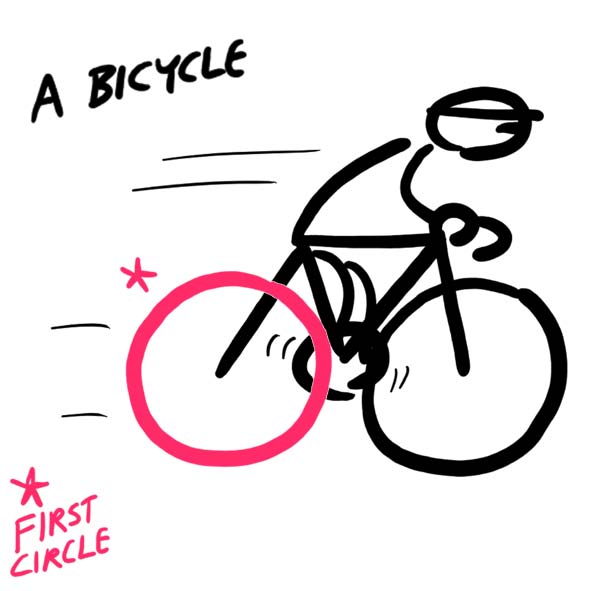
Once You’ve Started Drawing, the Hardest Part Soon Becomes Stopping
Because so many drawings can emerge from that first circle, once you’ve got one circle drawn, the others keep coming. Before you know it, you’ve drawn boxes and triangles, lines and arrows—and the idea that was buried in your head now takes shape before your eyes.
In fact, once you’ve started drawing, the hardest thing is stopping. That’s the power of our visual mind; once on a roll, watch out: Ideas are going to flow. This simplest of triggers—a circle with a name—is all you need to kick your visual mind into gear.
And if you do get stuck, you can always reignite your visual mind by spicing up your picture with new shapes, new arrows, and new labels.
Drawing Is Easy When You Start with the Basic Shapes
Ninety percent of all the business pictures you will ever need to create are composed of just seven basic building blocks:
1. Dot
2. Line
3. Arrow
4. Square
5. Triangle
6. Circle
7. Blob
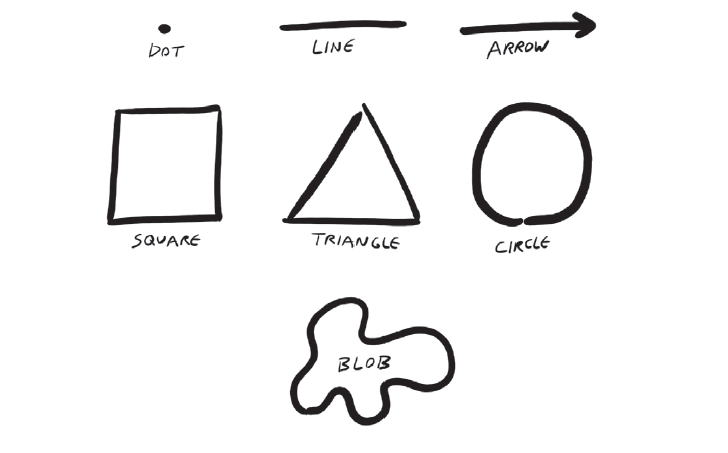
With just these seven shapes, you can draw almost anything.
There are only 7 shapes you need for persuasive drawings, says @Dan_Roam. Click To TweetYou Create All the Building Blocks the Same Way: Start by Drawing a Dot—and Then Just Keeping Pushing Your Pen
Drawing is like talking: There is silence until you say something. So say, “Dot,” and then draw a dot. The way you talk visually is by holding your pen on that dot and then drawing a line in the appropriate direction.
Which direction is appropriate? That depends on the basic shape you want to draw.
TOOL 3A: THE SEVEN BASIC BUILDING-BLOCK SHAPES
Here is how to draw the seven basic building-block shapes:
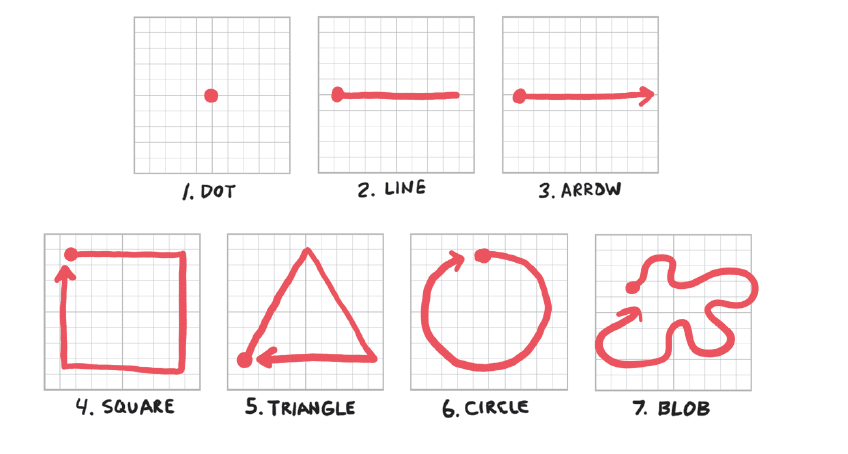
1. Dot. The starting point for all lines.
2. Line. The starting line for all shapes.
3. Arrow. A line that indicates direction, influence, or transition.
4. Square. Four dots connected by four lines. By lengthening lines, you create a rectangle. By skewing lines, you create a trapezoid.
5. Triangle. Three dots connected by three lines. By lengthening lines, you can create any three-sided shape.
6. Circle. A line that chases its own tail. By squeezing the circle, you create ovals.
7. Blob. A line that wanders before coming back home. The blob represents things that are unstructured—and perhaps problematic.
Every Picture You’re Going to Create in Business Is a Combination of These Simple Shapes
To create more meaningful pictures, you simply combine these seven building blocks. The combinations are pretty easy too; there are just six essential business pictures that illustrate and explain almost every idea you will explore.
You Can Create Most Basic Objects by Combining the Shapes and Then Erasing the Hidden Lines
- You create simple objects and people by combining squares, circles, and triangles.
- You draw a chart by stacking rectangles or slicing up a circle.
- You create a map by crossing two arrows and placing shapes in the appropriate quadrants.
- You create a timeline by lining up big, thick arrows (which are rectangles paired with pointy triangles) in a row.
- You can create elaborate flowcharts by sorting shapes into order and linking them with arrows.
- You can create equations by combining any number of your simple shapes.
Practice making these six pictures by combining your basic shapes. Being able to draw just these will account for 90 percent of all the business drawings you will ever need.
Reprinted from Draw to Win by Dan Roam with permission of Portfolio, an imprint of Penguin Publishing Group, a division of Penguin Random House LLC. Copyright © Dan Roam, 2016.
Once you start drawing, the hardest part is stopping, says @Dan_Roam Click To Tweet
nice…. Fast Company, BusinessWeek, and The Times of London all named The Back of the Napkin the #1 creativity and innovation book of the year.